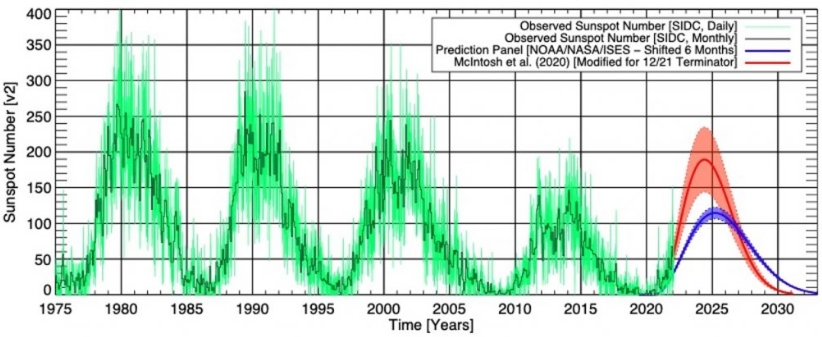Seasons and solar cycle
Along with the daily fluctuations in the ionosphere, there are also seasonal and longer-term variations in this complex set of regions. Different latitudes warm and cool with the seasons as the intensity of sunlight varies from place to place due to the tilt of Earth's axis. Similarly, the ionosphere varies seasonally as the location of the peak intensity of solar X-rays and UV light, which drive the rate of formation of ions, moves around on the globe. Seasonal changes in the chemistry of the atmosphere also play a role, influencing the rate of recombination events which remove ions from the atmosphere.
Longer term, the 11-year sunspot cycle has a strong influence on the upper reaches of the atmosphere, including the ionosphere. The brightness of the Sun, in visible light wavelengths that we can see, varies by less than 1/10th of one percent between the high and the low point of the sunspot cycle. However, the X-ray and UV output of the Sun varies much more throughout the solar cycle, fluctuating by a factor of 10 or more. Since these X-rays and UV radiation control the rate of ion formation that produces the ionosphere, large variations in these types of radiation lead to big changes in the ion densities in the ionosphere regions. Also, large geomagnetic storms triggered by solar flares and coronal mass ejections from the Sun can create severe temporary disruptions in the ionosphere.
A standard technique to observe the current structure of the ionospheric layers, is the HF sounding using a network of ionospheric stations, that allows the real-time mapping of the critical ionospheric characteristics over an extended region such as Europe. Based on these observations, empirical models provide predictions in long and short term of the disturbances in the ionospheric critical characteristics driven by the solar flux and by eruptions in the solar corona.
Long term observational datasets, and the relevant empirical and assimilative models are made available in PITHIA-NRF through contributions by its participating research groups in NOA, OE, INGV, RMI, IAP and BGD.

Observed sunspots (green) and NOAA/NASA/ISES predictions (blue) for solar cycle 25. An alternative approach by McIntosh et al. of NCAR predicts a higher peak, shown in red. (Credits: NASA).
For questions, please contact outreach@pithia-nrf.eu
